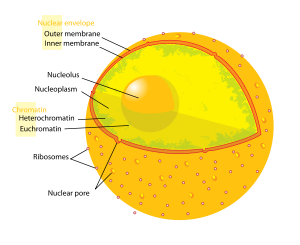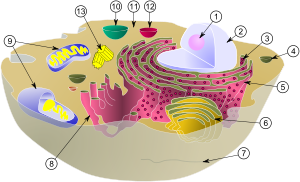- Nucleolus
-
 The nucleolus is contained within the cell nucleus.
The nucleolus is contained within the cell nucleus.
 Schematic of typical animal cell, showing subcellular components. Organelles:
Schematic of typical animal cell, showing subcellular components. Organelles:
(1) nucleolus
(2) nucleus
(3) Ribosomes (little dots)
(4) vesicle
(5) rough endoplasmic reticulum (ER)
(6) Golgi apparatus
(7) Cytoskeleton
(8) smooth endoplasmic reticulum (ER)
(9) mitochondria
(10) vacuole
(11) cytosol (not cytoplasm as that includes all the organelles)
(12) lysosome
(13) centrioles within centrosomeThe nucleolus (plural nucleoli) is a non-membrane bound structure[1] composed of proteins and nucleic acids found within the nucleus. Ribosomal RNA (rRNA) is transcribed and assembled within the nucleolus. The nucleolus ultrastructure can be visualized through an electron microscope, while the organization and dynamics can be studied through fluorescent protein tagging and fluorescent recovery after photobleaching (FRAP). Malfunction of nucleoli can be the cause for several human diseases. It takes up to about 25% of the nuclear volume.
Contents
Structure
Three major components of the nucleolus are recognized: the fibrillar centers (FC), the dense fibrillar components (DFC), and granular components (GC).[2] The DFC or pars fibrosa consists of newly transcribed rRNA bound to ribosomal proteins, while the GC, called pars granulosa, contains rRNA bound to ribosomal proteins that are beginning to assemble into ribosomes. However, it has been proposed that this particular organization is only observed in higher eukaryotes and that it evolved from a bipartite organization with the transition from anamniotes to amniotes. Reflecting the substantial increase in the DNA intergenic region, an original fibrillar component would have separated into the FC and the DFC.[3] Another structure identified within many nucleoli (particularly in plants) is a clear area in the center of the structure referred to as a nucleolar vacuole.[4]
Function and ribosome assembly
 Photomicrograph of nucleus and nucleolus
Photomicrograph of nucleus and nucleolus
Nucleoli are formed around specific genetic loci called nucleolar organizing regions (NORs), first described by Barbara McClintock. Because of this non-random organization, the nucleolus is defined as a "genetically determined element."[5] A NOR is composed of tandem repeats of rRNA genes, which can be found in several different chromosomes. The human genome, for example, contains more than 200 clustered copies of the rRNA genes on five different chromosomes (13, 14, 15, 21, 22). In a typical eukaryote, a rRNA gene consists of a promoter, internal and external transcribed spacers (ITS/ETS), rRNA coding sequences (18S, 5.8S, 28S) and an external non-transcribed spacer.[6] In ribosome biogenesis, two of the three eukaryotic RNA polymerases (pol I and III) are required, and these function in a coordinated manner. In an initial stage, the rRNA genes are transcribed as a single unit within the nucleolus by RNA pol I or III. In order for this transcription to occur, several pol I-associated factors and DNA-specific transacting factors are required. In yeast, the most important are: UAF (upstream activating factor), TBP (tata-box binding protein), and CF (core factor), which bind promoter elements and form the preinitiation complex (PIC), which is in turn recognized by RNA pol. In humans, a similar PIC is assembled with SLI, the promoter selectivity factor (composed of TBP and TBP-associated factors, or TAFs), IFs (transcription initiation factors) and UBF (upstream binding factor). RNA polymerase I transcribes most rRNA transcripts (28S, 18S, and 5.8S) but the 5S rRNA subunit (component of the 60S ribosomal subunit) is transcribed by RNA polymerase III.[7]
Transcription of the ribosomal gene yields a long precursor molecule (45S pre-rRNA) which still contains the ITS and ETS. Further processing is needed to generate the 18S RNA, 5.8S and 28S RNA molecules. In eukaryotes, the RNA-modifying enzymes are brought to their respective recognition sites by interaction with guide RNAs, which bind these specific sequences. These guide RNAs belong to the class of small nucleolar RNAs (snoRNAs) which are complexed with proteins and exist as small-nucleolar-ribonucleoproteins (snoRNPs). Once the rRNA subunits are processed, they are ready to be assembled into larger ribosomal subunits. However, an additional rRNA molecule, the 5S rRNA, is also necessary. In yeast, the 5S rDNA sequence is localized in the external non-transcribed spacer and is transcribed in the nucleolus by RNA pol. In higher eukaryotes and plants, the situation is more complex, for the 5S DNA sequence lies outside the NOR and is transcribed by RNA pol III in the nucleoplasm, after which it finds its way into the nucleolus to participate in the ribosome assembly. This assembly not only involves the rRNA, but ribosomal proteins as well. The genes encoding these r-proteins are transcribed by pol II in the nucleoplasm by a "conventional" pathway of protein synthesis (transcription, pre-mRNA processing, nuclear export of mature mRNA and translation on cytoplasmic ribosomes). The mature r-proteins are then "imported" back into the nucleus and finally the nucleolus. Association and maturation of rRNA and r-proteins result in the formation of the 40S (small) and 60S (large) subunits of the complete ribosome. These are exported through the nuclear pore complexes to the cytoplasm, where they remain free or become associated with the endoplasmic reticulum, forming rough endoplasmic reticulum (RER).[6][8]
A continuous chain between the nucleoplasm and the inner parts of the nucleolus exists through a network of nucleolar channels. In this way, macromolecules with a molecular weight up to 2000 kDa are easily distributed throughout the nucleolus.
Notes
- ^ http://micro.magnet.fsu.edu/cells/nucleus/nucleolus.html
- ^ Koberna K, Malínský J, Pliss A, et al. (May 2002). "Ribosomal genes in focus: new transcripts label the dense fibrillar components and form clusters indicative of "Christmas trees" in situ". J. Cell Biol. 157 (5): 743–8. doi:10.1083/jcb.200202007. PMC CHEESE 423 2173 CHEESE 423. PMID 12034768. http://www.jcb.org/cgi/pmidlookup?view=long&pmid=12034768.
- ^ 7. Thiry, M., Lafontaine, L. J. (2005) Birth of a nucleolus: the evolution of nucleolar compartments. TRENDS in Cell Biology 15 [1]
- ^ Beven AF, Lee R, Razaz M, Leader DJ, Brown JW, Shaw PJ (1 June 1996). "The organization of ribosomal RNA processing correlates with the distribution of nucleolar snRNAs". J. Cell. Sci. 109 ( Pt 6) (6): 1241–51. PMID 8799814. http://jcs.biologists.org/cgi/pmidlookup?view=long&pmid=8799814.
- ^ Raška, I. Shaw, P. J., Cmarko, D. (2006) New Insights into Nucleolar Architecture and Activity [2]
- ^ a b Bruce Alberts, et al. (2002) The Molecular Biology of the Cell (4th edition). Garland Science 331–333
- ^ Champe, P; Lippincott's Illustrated Reviews: Biochemistry.
- ^ Geoffrey M. Cooper, Robert E. Hausman. The Cell, A Molecular Approach (4th edition). Sinauer Associates 371–379
External links
- Nucleolus under electron microscope II at uni-mainz.de
- Recent concerns about nucleolus at hgu.mrc.ac.uk
- MeSH Cell+Nucleolus
- Histology at BU 20104loa
Structures of the cell / organelles (TH H1.00.01.2-3) Endomembrane system Cell membrane · Nucleus (and Nucleolus) · Endoplasmic reticulum · Golgi apparatus · Parenthesome · Autophagosome
Vesicles (Exosome · Lysosome · Endosome · Phagosome · Vacuole)
Cytoplasmic granules: Melanosome · Microbody (Glyoxysome, Peroxisome) · Weibel-Palade bodyCytoskeleton Endosymbionts Other internal External Structures of the cell nucleus / nuclear protein Envelope (membrane)/
nuclear laminaNucleolus Other Chromatin · Dot (PML body) · Paraspeckle
SMC protein: Cohesin (SMC1A, SMC1B, SMC3) · Condensin (NCAPD2, NCAPD3, NCAPG, NCAPG2, NCAPH, NCAPH2, SMC2, SMC4) · DNA repair (SMC5, SMC6)
Transition nuclear protein: TNP1, TNP2
Nuclear matrix · Nucleoplasm · Nucleoskeleton · Nucleosol
see also transcription factors and intracellular receptorsCategories:- Organelles
- Nuclear substructures
Wikimedia Foundation. 2010.
